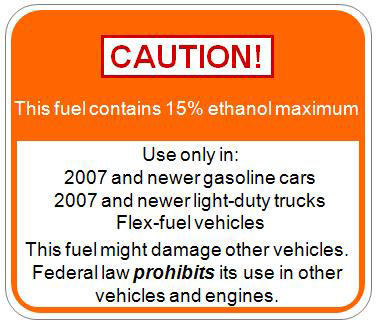EPA Issues Guidance On UST Compatibility And Labeling Requirements For E15
 The U.S. Environmental Protection Agency (EPA) has issued guidance on the compatibility of underground storage tanks (USTs) with gasoline containing greater than ten percent ethanol or diesel containing greater than twenty percent biodiesel. The guidance is intended to assist UST owners and operators in meeting the existing federal UST compatibility requirements. For a complete overview, you can view the PDF at this location: http://www.epa.gov/oust/altfuels/biofuels-compat-guidan ce.pdf
The U.S. Environmental Protection Agency (EPA) has issued guidance on the compatibility of underground storage tanks (USTs) with gasoline containing greater than ten percent ethanol or diesel containing greater than twenty percent biodiesel. The guidance is intended to assist UST owners and operators in meeting the existing federal UST compatibility requirements. For a complete overview, you can view the PDF at this location: http://www.epa.gov/oust/altfuels/biofuels-compat-guidan ce.pdf
EPA also issued fuel pump labeling and other requirements for gasoline blends containing more than ten and up to fifteen percent ethanol, known as E15. http://www.epa.gov/otaq/regs/fuels/additive/e15/index.htm
UST Guidance: To be in compliance with EPA's UST regulations, owners and operators of UST systems storing ethanol-blended fuels greater than ten percent ethanol or biodiesel-blended fuels greater than twenty percent biodiesel must use compatible equipment.
EPA concurred with NAFA's recommendation that the threshold for biodiesel be set at B20. EPA had requested feedback on what blend would be appropriate as a cutoff – that is, up to what blend level is the compatibility of biodiesel with UST equipment similar to the compatibility of petroleum diesel with UST equipment, and at what blend level do the known incompatibilities and the unknown risks necessitate further assurance of compatibility? EPA agreed with NAFA's comments that B20 is more commonly used for vehicle fleets, while B5 is more commonly available at retail facilities, and that field experience with B20 has been positive.
EPA considers the following parts of the UST system to be critical for demonstrating compatibility:
- Tank or internal tank lining
- Piping
- Line leak detector
- Flexible connectors
- Drop tube
- Spill and overfill prevention equipment
- Submersible turbine pump and components
- Sealants (including pipe dope and thread sealant), fittings, gaskets, o-rings, bushings, couplings, and boots
- Containment sumps (including submersible turbine sumps and under dispenser containment)
- Release detection floats, sensors, and probes
- Fill and riser caps
- Product shear valve
Acceptable methods for owners and operators of UST systems storing ethanol-blended fuels greater than ten percent ethanol or biodiesel-blended fuels greater than twenty percent biodiesel to demonstrate compatibility are:
Use components that are certified or listed by a nationally recognized, independent testing laboratory (for example, Underwriters Laboratories) for use with the fuel stored;
Use components approved by the manufacturer to be compatible with the fuel stored. EPA considers acceptable forms of manufacturer approvals to:
- Be in writing;
- Indicate an affirmative statement of compatibility;
- Specify the range of biofuel blends the component is compatible with; and
- Be from the equipment manufacturer, not another entity (such as the installer or distributor); or
- Use another method determined by the implementing agency to sufficiently protect human health and the environment. EPA will work with states as they evaluate other acceptable methods.
E15 Labeling: EPA concluded that a labeling requirement is needed to help ensure that shipments of E15 and other fuel are delivered into the appropriate storage tanks at retail and fleet fueling facilities and not improperly commingled. The new orange and black label must appear on fuel pumps that dispense E15. This label will help inform consumers about which vehicles can use E15. This label will also warn consumers against using E15 in vehicles older than model year 2001, motorcycles, watercraft, and gasoline-powered equipment such as lawnmowers and chainsaws.
Over the past year, EPA issued two partial waivers under the Clean Air Act that in sum allow E15 to be sold for use in model year 2001 and newer cars and light trucks. EPA based its waiver decisions on testing and analysis showing that these vehicles could continue to meet emission standards if operated on E15. However, EPA does not mandate the use of E15. If other state, federal, and industry practices also support this introduction, E15 may become available in the marketplace. As a result, EPA anticipates that some UST system owners and operators may choose to store higher percentages of ethanol in their UST systems.
This action will help to further reduce the risks of potential misfueling that could result in damage to the vehicle or equipment and in associated emission increases that pose threats to human health and the environment.
 The U.S. Environmental Protection Agency (EPA) has issued guidance on the compatibility of underground storage tanks (USTs) with gasoline containing greater than ten percent ethanol or diesel containing greater than twenty percent biodiesel. The guidance is intended to assist UST owners and operators in meeting the existing federal UST compatibility requirements. For a complete overview, you can view the PDF at this location: http://www.epa.gov/oust/altfuels/biofuels-compat-guidan ce.pdf
The U.S. Environmental Protection Agency (EPA) has issued guidance on the compatibility of underground storage tanks (USTs) with gasoline containing greater than ten percent ethanol or diesel containing greater than twenty percent biodiesel. The guidance is intended to assist UST owners and operators in meeting the existing federal UST compatibility requirements. For a complete overview, you can view the PDF at this location: http://www.epa.gov/oust/altfuels/biofuels-compat-guidan ce.pdf